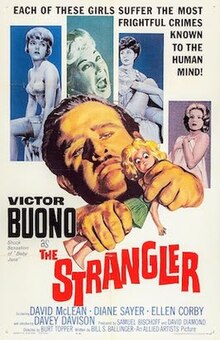The Hillside Strangler, later the Hillside Stranglers, is the media epithet for one, later discovered to be two, American serial killers who terrorized Los Angeles, California, between October 1977 and February 1978, with the nicknames originating from the fact that many of the victims' bodies were discovered in the hills surrounding the city.
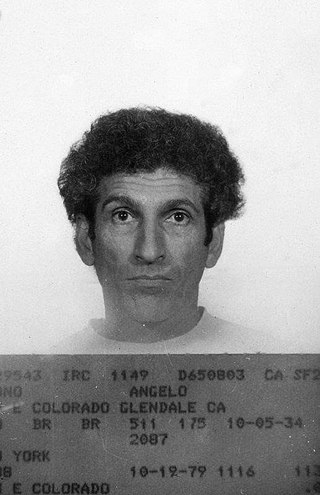
Angelo Anthony Buono Jr. was an American serial killer, kidnapper and rapist who, together with his adopted cousin Kenneth Bianchi, were known as the Hillside Stranglers. Buono and Bianchi were convicted of killing ten young women in Los Angeles, California, between October 1977 and February 1978.
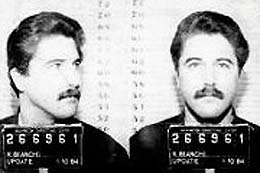
Kenneth Alessio Bianchi is an American serial killer, kidnapper, and rapist. He is known for the Hillside Strangler murders committed with his cousin Angelo Buono Jr. in Los Angeles, California, as well as for murdering two more women in Washington by himself. Bianchi is currently serving a sentence of life imprisonment in Washington State Penitentiary for these crimes. Bianchi was also at one time a suspect in the Alphabet murders, three unsolved murders in his home city of Rochester, New York, from 1971 to 1973. He is up for parole in 2025.

Peter Kürten was a German serial killer, known as The Vampire of Düsseldorf and the Düsseldorf Monster, who committed a series of murders and sexual assaults between February and November 1929 in the city of Düsseldorf. In the years before these assaults and murders, Kürten had amassed a lengthy criminal record for offences including arson and attempted murder. He also confessed to the 1913 murder of a nine-year-old girl in Mülheim am Rhein and the attempted murder of a 17-year-old girl in Düsseldorf.

Albert Henry DeSalvo was an American murderer and rapist who was active in Boston, Massachusetts, in the early 1960s. He is known to have confessed to being the "Boston Strangler", a serial killer who murdered thirteen women in the Boston area between 1962 and 1964. Lack of physical evidence supported DeSalvo's confession, and he was only prosecuted in 1967 for a series of unrelated rapes, for which he was convicted and imprisoned until his death in 1973. DeSalvo's claims to have murdered multiple women was disputed, and debates continued regarding which crimes he truly had committed.
The Boston Strangler is the name given to the murderer of 13 women in Greater Boston during the early 1960s. The crimes were attributed to Albert DeSalvo based on his confession, on details revealed in court during a separate case, and DNA evidence linking him to the final victim.

Victor Charles Buono was an American actor, comic, and briefly a recording artist. He was known for playing the villain King Tut in the television series Batman (1966–1968) and musician Edwin Flagg in What Ever Happened to Baby Jane? (1962), the latter of which earned him Academy Award and Golden Globe Award nominations. He was a busy actor from his late teens until his death at the age of 43 and, with his large size and sonorous voice, he made a career of playing men much older than he was.
Joachim Georg Kroll was a German serial killer, child molester, necrophile and cannibal who murdered a minimum of eight women and young girls in the Ruhr metropolitan region from 1955 until his arrest on 3 July 1976. He was convicted of eight murders and one attempted murder but confessed to a total of 14. He was sentenced to life imprisonment on 8 April 1982.
The Hillside Strangler is a 2004 horror film directed by Chuck Parello and written by Stephen Johnston, based on the true story of Kenneth Bianchi and Angelo Buono Jr., the Hillside Strangler serial killers. The film stars C. Thomas Howell as Bianchi and Nicholas Turturro as Buono.
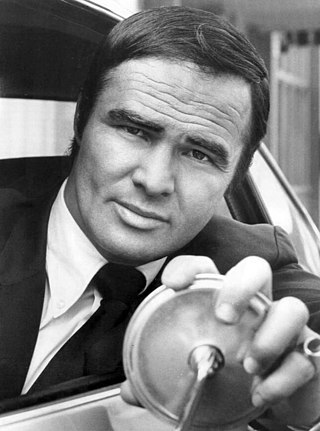
Dan August is an American drama series that aired on ABC from September 23, 1970, to April 8, 1971. Burt Reynolds played the title character. Reruns of the series aired in prime time on CBS from May to October 1973 and from April to June 1975.

The Haunted Strangler is a 1958 British horror film directed by Robert Day and starring Boris Karloff, Jean Kent, Elizabeth Allan, and Anthony Dawson.

Henry Louis Wallace, also known as the “Taco Bell Strangler”, is an American serial killer who killed eleven black women in South Carolina and North Carolina from March 1990 to March 1994. He is currently awaiting execution at Central Prison in Raleigh.
Burt Topper was an American film director and screenwriter best known for cult films aimed at teenagers.
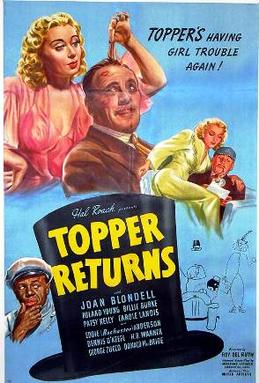
Topper Returns is a 1941 American supernatural comedy thriller film directed by Roy Del Ruth and starring Joan Blondell, Roland Young, Carole Landis and Billie Burke. The third and final installment in the initial series of supernatural comedy films inspired by the novels of Thorne Smith, it succeeds Topper (1937) and Topper Takes a Trip (1938).
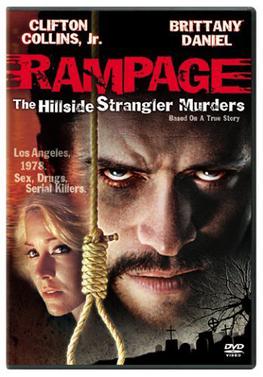
Rampage: The Hillside Strangler Murders is a 2006 American direct-to-video crime thriller about the Hillside Strangler murders. The film featured Brittany Daniel, Lake Bell and Michelle Borth, with Tomas Arana and Clifton Collins Jr. playing the killers Angelo Buono and Kenneth Bianchi, respectively. It was directed by Chris Fisher.

Guy Georges is a French serial killer and serial rapist, dubbed le tueur de l'Est Parisien or The Beast of the Bastille. He was convicted on 5 April 2001, of murdering seven women between 1991 and 1997. He was sentenced to life in prison without the possibility of parole for 22 years.

Rodney James Alcala was an American serial killer, rapist, and convicted sex offender who was sentenced to death in California for five murders committed between 1977 and 1979. He also pleaded guilty and received a sentence of 25 years to life for two further murders committed in New York. He was also indicted for a murder in Wyoming, although the charges filed there were dropped. While Alcala has been conclusively linked to eight murders, the true number of victims remains unknown and could be as high as 130.
The Honolulu Strangler, also known as The Honolulu Rapist, is the nickname given to an unidentified serial killer who is believed to have killed five women in Hawaii from 1985 and 1986. He is the second known serial killer active in the state.

Harrison Frank "Marty" Graham is an American serial killer who murdered seven women in Philadelphia, Pennsylvania between mid-1986 to mid-1987, keeping their remains in his apartment. In 1988, he was found guilty on all charges and sentenced to death, but his sentences were later commuted to life imprisonment. Graham lived less than a mile and a half away from the home of another murderer, Gary M. Heidnik, who was also arrested during the same time period for similar crimes.

Steven Washington Jr. was an American serial killer who was sentenced to life in prison for the murders of three elderly women in St. Petersburg, Florida. Dubbed the Window-Screen Rapist by the press, Washington's crimes were committed between August and December 1963 when he was only 15 years old, which makes him one of the youngest serial killers in history. He died while in prison 2004.
